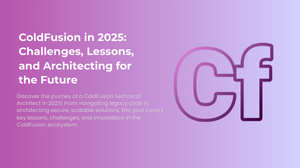ColdFusion in 2025: Key Challenges and Architectural Lessons

Introduction
ColdFusion frequently slips under the radar in modern technology conversations, but it continues to power key systems in many organisations, including mine. I’ve spent the last two years working extensively with ColdFusion in real-world production situations, and it’s been a journey filled with both obstacles and opportunities. In this post, I’d want to share some of the lessons I’ve learnt, not only about the technology, but also about what it takes to progress from developer to technical architect inside a ColdFusion ecosystem.
As a Senior Software Engineer and Technical Architect, I’ve focused on driving strategic initiatives while engaging closely with stakeholders to ensure alignment with organizational goals. A significant part of my work has involved acquiring and manipulating spatial data within GIS environments, a critical component in enhancing the mapping and geographical applications.
Beyond coding, I’ve been responsible for maintaining ColdFusion servers across multiple environments, applying best practices in security, automation, and performance monitoring. My daily workflow is split between hands on coding (70%) and system level oversight (30%), monitoring servers, troubleshooting vulnerabilities, managing patches, and ensuring smooth deployments. I also mentor junior developers, offering technical guidance that supports their growth and contributes to a collaborative, high-performing team culture. This multifaceted role has allowed me to not only influence technology landscape but also foster innovation and cohesion within the team.

Lessons Learned Along the Way
Over time, I’ve picked up a set of invaluable lessons both technical and human that have played a pivotal role in shaping my journey as a ColdFusion Technical Architect. These lessons go beyond code and architecture; they also focus on leadership, collaboration, and long-term thinking. Here’s a closer look at some of the key insights I’ve gained:
Modernizing Legacy Code is a balancing art
When working with an established ColdFusion codebase, there is always the desire to start from scratch. The system may feel outdated, difficult to maintain, or riddled with inefficiencies. However, legacy systems often contain deeply embedded business logic, hidden dependencies, and years of patchwork fixes that are crucial to the overall functionality. In my experience, jumping straight into a full rewrite can be risky, it not only disrupts the business but can also introduce unforeseen issues that complicate things further.
A perfect example of this comes from my work, which was originally built with ColdFusion more than 20 years ago. Over time, various features were added or patched together to meet the growing demands of the business. As a result, the code became tightly coupled with business logic, and untangling it was no easy feat. Some parts of the system were convoluted, and others had significant technical debt that made refactoring a challenge. However, instead of throwing everything away, I decided on a more measured, incremental approach.
Rather of rebuilding the entire backend system, I focused on redesigning smaller, more modular components that interact with the existing code. This allowed us to keep the system’s functional aspects while gradually incorporating modern approaches. By splitting down the module into individual components, we could make modifications gradually, lowering the danger of large-scale disruptions.
However, the most difficult problem was explaining the benefit of these modest advances to stakeholders. Many of them did not always recognise the technical debt hiding beneath the surface. To assist them understand, I demonstrated actual results by comparing system performance before and after each incremental update, emphasising the reduced downtime, and highlighting potential scalability benefits. By framing it as a strategic, long-term approach, I was able to secure their support while demonstrating how we were enhancing the system without entirely redesigning it.
Security and Authentication Are Ongoing Responsibilities
In the world of software development, security is not a one-time activity that you implement and then forget about. It’s a constantly evolving problem, especially when working with public-facing applications where risks can alter quickly and unpredictably. One of the most important lessons I’ve learnt is that security is not a one-time job; it is an ongoing responsibility that necessitates vigilance, proactive measures, and a continual improvement mindset.
One of the most significant security enhancements I spearheaded was the Azure AD Single Sign-On (SSO) connection for our ColdFusion-based platform. While this was a significant step towards simplifying user authentication and enhancing security, it was only one component of a much wider security system. Single Sign-On enabled us to centralise authentication, providing greater control over user access, while also laying the groundwork for enforcing other security best practices throughout the system.
However, implementing SSO did not mark the end of the journey. I’ve learnt over time that security is an iterative process. Regular token validation and secure session handling have become essential components of our day-to-day operations. To prevent session hijacking, I validate all tokens on a frequent basis, and I’ve introduced measures to ensure that session timeouts and re-authentication processes are properly handled. These small details make a huge difference in safeguarding our application from unauthorized access.
Documentation is architecture’s best friend
One of the most important yet underrated aspects of system architecture is documenting the decision-making process. Over time, I’ve made it a habit to document why specific libraries or APIs were chosen, why endpoints were designed in certain ways, and how modules fit into the larger system. This documentation serves as a technical roadmap for others or even for myself down the line ensuring that the reasoning behind architectural decisions is clear and accessible. This becomes especially useful when changes are needed or new team members join, as it provides a deeper understanding of the system’s structure and purpose.
For example, when integrating Azure AD Single Sign-On (SSO) into our ColdFusion application, I documented the decision-making process behind selecting SSO for centralized authentication, the challenges we anticipated, and how it aligned with security goals (Essential Eight). This allowed new team members to understand not just how the system works but why it was structured this way. Documentation also proved invaluable when we faced a security audit, as we were able to easily provide details on our token validation process. In short, good documentation fosters better communication, reduces errors, and ensures that the architecture remains understandable and adaptable over time.
ColdFusion still has a place, when used right
ColdFusion doesn’t always get the respect it deserves. As a language that has been around for decades, it can be easy to dismiss it as outdated, but my experience has taught me that it’s not the tool itself that defines the quality of a system — it’s how you use it. ColdFusion, when paired with the right architecture and modern development practices, can still power robust, scalable, and secure applications. I’ve found that embracing ColdFusion’s strengths, such as its ease of rapid development and powerful integration capabilities, while using modern patterns, has allowed us to build solutions that are both efficient and future-proof.
For instance, we’ve successfully integrated ColdFusion with modern authentication systems like Azure AD SSO, ensuring that our platform aligns with current security standards. Additionally, we’ve leveraged AWS services to scale our platform and integrate with cloud-based tools, allowing us to take advantage of features such as S3 storage, Lambda functions, and RDS for improved performance and flexibility. We’ve also embraced clean REST APIs, enabling seamless communication between ColdFusion and other systems. By adhering to principles such as modular design and keeping the codebase flexible and maintainable, we’ve ensured that our ColdFusion applications remain scalable and adaptable as the system grows. Through these efforts, I’ve seen firsthand that ColdFusion is far from obsolete it’s a tool that, when used thoughtfully and with care, can continue to serve businesses well in 2025 and beyond.
Support can be sparse, so build your own network
Unlike more mainstream languages, ColdFusion doesn’t have an overwhelming number of local user groups, StackOverflow activity, or readily available consultants, especially in Australia. This lack of readily available support can sometimes feel isolating, but it also pushes you to become more self-sufficient and proactive. I’ve learned that, in the absence of a large, active community nearby, it’s crucial to create your own network of support. I’ve started writing blogs to share insights and solutions with others, engaging with the broader ColdFusion community online through forums and social media, and experimenting with solutions when documentation falls short. This approach has not only allowed me to solve problems independently but has also helped others in similar situations.
For example, when working on integrating Azure AD SSO with ColdFusion, I found that there were few resources specific to this combination. Rather than getting stuck, I dove into documentation, trial and error, and shared my findings on my blog. As a result, I not only solved the issue for my team but also contributed back to the community, helping others who might be struggling with the same integration. By making these efforts to connect with like-minded professionals and share knowledge, I’ve found a sense of collaboration and support that benefits both me and others. In the end, the ColdFusion community might not be as large as some other ecosystems, but it is filled with passionate individuals who are always eager to help when you reach out.
Conclusion
Working as a ColdFusion Architect isn’t just about keeping old systems alive it’s about transforming them into something modern, secure, and future-ready. Throughout my journey, I’ve learned that the role demands more than just coding skills; it requires thinking strategically about the long-term health of the platform, mentoring others, and advocating for solutions that balance innovation with stability. It’s a blend of leadership and technical expertise, where your decisions impact both the immediate needs of your team and the future of the product.
I’m incredibly proud of how far we’ve come, especially in areas like modernizing legacy code, integrating secure authentication systems, and scaling our ColdFusion applications to meet the needs of the business. But I’m also aware that this journey is ongoing. We’re always learning, adapting, and improving particularly as we continue to evolve ColdFusion into something even more powerful, capable of meeting the demands of today’s technological landscape. While ColdFusion might not always get the recognition it deserves, I’m excited about what lies ahead and the opportunities to continue pushing the boundaries of what we can build with it.
